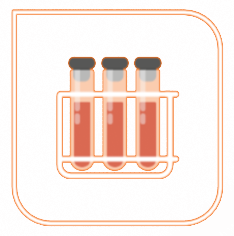

PeliClass sheep anti human IgG1
Kit for quantitative determination of human IgG subclasses in serum and plasma on the Beckman IMMAGE / IMMAGE 800.
| Article number | M1891 |
| Product group | IgG subclasses IMMAGE |
| Technique | Nephelometry/turbidimetry |
General information
Dive into the fascinating world of human IgG subclasses, namely IgG1, IgG2, IgG3, and IgG4, each carrying unique biochemical traits that have been extensively documented 1-5. These distinctions among IgG subclasses manifest in pivotal biological functions, encompassing antigen recognition, complement activation, and interaction with cell surface receptors. A plethora of studies shed light on the correlation between irregular serum levels of IgG subclasses and various disease states 6.
One captivating area of exploration involves the striking link between selective IgG2 subclass deficiency and heightened vulnerability to viral or bacterial infections, a connection thoroughly substantiated by ample research 4,5. Patients with recurrent upper and lower respiratory tract infections have been noted to exhibit low serum levels of IgG2 or IgG3, further emphasizing the significance of these subclasses 4,5. Moreover, intriguing findings have emerged, associating notably low IgG4 serum concentrations with recurrent sino-pulmonary infections 7.
The intrigue extends beyond infectious contexts. Aberrations in serum levels of IgG subclasses have been observed in realms ranging from autoimmune diseases to neurological disorders and HIV infections 4,6. This intricate interplay between IgG subclasses and diverse health conditions underscores the multifaceted nature of the immune response.
Delve into the captivating world of human IgG subclasses and their far-reaching implications for our understanding of health and disease. Explore the wealth of knowledge amassed through meticulous research, paving the way for insights into immunology’s intricate tapestry.
Test principles
Experience swift and precise measurement of human IgG subclasses (IgG1, IgG2, IgG3, and IgG4) with our PeliClass Human IgG Subclass Plus Kit.
Our advanced nephelometric method gauges IgG1 and IgG2 in serum using a highly avid anti-IgG subclass antiserum. For IgG3 and IgG4, our turbidimetric approach employs monospecific anti-IgG subclass antibodies on a latex reagent, ensuring unmatched sensitivity.
Backed by meticulous fractionation, our sheep anti-human IgG subclass sera eliminate unwanted subclasses. Carefully selected polyclonal reagents ensure precision and specificity. Nephelometric and turbidimetric quantifications measure immune complexes via scattered light and light transmission, respectively, while the included calibrators establish accurate subclass concentrations.
Rigorous IgG subclass control sera validation ensures reliable results. Calibrators are aligned with WHO 67/97 11 standards, securing precision – IgG1 at 6.210 g/L, IgG2 at 3.450 g/L, IgG3 at 0.390 g/L, and IgG4 at 0.591 g/L.
Elevate your IgG subclass analysis with the PeliClass Human IgG Subclass Plus Kit. Order now for gold-standard accuracy.
Storage and stability

All components maintain stability until the indicated expiry date on the label when stored within the range of 28°C. Please note that transportation conditions may vary from storage conditions. It is crucial to avoid freezing the IgG3 and IgG4 latex reagents.
Once opened and stored between 2-8°C, the components remain stable for a duration of 1 month, factoring in the expiry date specified on the label. Upon completing your daily tasks, ensure to return the components to the 2-8°C storage environment. Before storing the reagent cartridges, kindly replace the evaporation caps with screw caps to ensure proper sealing and preservation.
While the calibration curves exhibit stability for a minimum of 1 month, we strongly recommend the regular use of control sera to verify the ongoing validity of these calibration curves. Your adherence to these guidelines guarantees optimal performance and accurate results.
Package contents
Introducing the PeliClass Human IgG Subclass Plus Kit, enabling precise quantification of all four human IgG subclasses across 50 tests, complete with calibrators and controls.
For your convenience, individual components listed on the initial page of this package insert are available for separate ordering.
|
Sheep antibodies against human IgG1 |
1x 2.4 mL |
M1891 |
|
Sheep antibodies against human IgG2 |
1x 2.9 mL |
M1892 |
|
Latex enhanced sheep antibodies against human IgG3 |
1x 4.0 mL |
M1893 |
|
Latex enhanced sheep antibodies against human IgG4 |
1x 4.0 mL |
M1894 |
|
Human IgG subclass calibrator set |
7x 1.0 mL |
M1896 |
|
Human IgG subclass control 1 |
1x 1.0 mL |
M1897 |
|
Human IgG subclass control 2 |
1x 1.0 mL | M1898 |
Precautions
Our calibrators and controls consist of liquid human sera. While these human sera have undergone thorough testing for disease-transmitting markers in line with current EU guidelines and GMP, it is essential to regard all human-origin components as potentially infectious. Disposal of waste materials should strictly adhere to your laboratory’s regulations.
Please be aware that the reagent cannot be assumed to be completely free from infectious agents.
For optimal stability, store all components between 2-8°C until the expiration date indicated on the label. Please note that transport conditions might vary from storage conditions. To ensure their integrity, avoid freezing the IgG3 and IgG4 latex reagents. Your commitment to these safety and storage guidelines ensures the well-being of all individuals involved and accurate results.
Test sample handling
Both serum and plasma samples (EDTA and Na-heparin) are suitable for testing purposes. It is recommended that samples be as freshly collected as possible or stored within the 2-8°C range. In cases where samples will not be tested within 1 week, freezing between 18°C to 30°C is advised. Extended storage up to 3 months is possible under these conditions.
Please avoid subjecting samples to repeated freeze-thaw cycles, as this may compromise the integrity of the analyte. In instances where samples appear lipemic or turbid, it is necessary to clarify them through centrifugation prior to testing. Samples that cannot be successfully clarified should not be used in testing procedures.
Unless otherwise indicated, it is important to refrain from manually diluting the samples before use. Adhering to these sample handling guidelines guarantees accurate and reliable test results.
References
Find out more information about the scientific background of the product.
Shakib F. (1986)
(Volume editor) Basic and Clinical Aspects of IgG Subclasses (Monographs in Allergy 19) Karger.
Shakib F. (1990)
(Editor) The human IgG subclasses Pergamon Press.
Vlug A. et al. (1989)
Eur. Clin. lab. 8: 26.
Jefferis R. and Kumararatne D.S. (1990)
Clin. Exp. Immunol. 81: 357.
Hamilton R.C. (1987)
Clin. Chem. 33: 1707.
Vries E. de et al. (2006)
Clin. Exp. Immunol. 145: 204.
Beck C.S. and Heiner D.C. (1981)
Am. Rev. Respir. Dis. 124: 94.
Giessen M. et al. (1974)
Immunology 27: 655.
Goossen P.C.M. et al. (1981)
J. Immunol. Methods 40: 339.
Vlug A. et al. (1994)
Ann. Biol. Clin. 52: 561.
Klein F. et al. (1985)
Clin. Chem. Acta. 150: 119.
Lepage N. et al. (2010)
Clin. Biochem. 43: 694.
Partners of AntiBodyChain


Are you interested in a product or do you have questions?
Fill in the information below.
